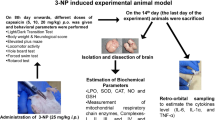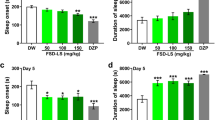Abstract
The effect of Ca2+-homopantothenate (HOPA) treatment (250 mg/kg for 5 d) has been studied by evaluating the specific activity of enzymes related to: glycolytic pathway (hexokinase, phosphofruc-tokinase, pyrurate kinase, lactate dehydrogenase), tricarboxylic acid cycle (citrate synthase, malate dehydrogenase), mitochondrial electron transfer chain (succinate dehydrogenase, cytochrome oxidase), NADH redox state (NADH cytochromec reductase), acetylcholine metabolism (acetylcholinesterase), and glutamate metabolism (glutamate dehydrogenase). The enzymatic activity assays were performed on homogenatein toto, nonsynaptic mitochondria and synaptosomes isolated from: cerebral cortex, hippocampus, striatum, hypothalamus, medulla oblongata, and cerebellum of normoxic rats and rats submitted to intermittent normobaric hypoxia (90:10, N2:O2). In normoxic rats, HOPA was unable to induce any modification. Hypoxiaper se induced a decrease in the activity of synaptosomal cytochrome oxidase in cerebral cortex, hippocampus, and cerebellum.
Similar content being viewed by others
References
Benzi G., Agnoli A., Dagani F., Ruggieri S., and Villa R. F. (1979) Effect of phenobarbital on cerebral energy state and metabolism.Stroke 10, 733–735.
Benzi, G., Villa, R. F., Dossena M., Vercesi L., Gorini A., and Pastoris O. (1984) Cerebral endogenous substrate utilization during the recovery period after profound hypoglycemia.J. Neurosci. Res. 11, 437–450.
Bielicki L. and Krieglstein J. (1976) Decreased GABA and glutamate concentration in rat brain after treatment with 6 aminonicotinamide.Naunyn Schmiedebergs Arch. Pharmacol. 294, 157–160.
Breivik H., Safar, P., Sands P., Lind B., Lust P., Mullie A., Orr M., Renck, H., and Snyder J. W. (1978) Clinical feasibility trials of barbiturate therapy after cardiac arrest.Crit. Care Med. 6, 228–244.
Brody T. M. and Bain J. A. (1954) Barbiturates and oxidative phosphorylation.J. Pharmacol. 110, 148–156.
Chapman A. G., Nordstrom C. H., and Siesjö B. K. (1978) Influence of phenobarbital anaesthesia on carbohydrate and amino acid metabolism in rat brain.Anesthesiology 48, 175–188.
Corkill G., Sivalingam S., Reitan J. A., Gilroy B. A., and Helphrey M. G. (1978) Dose dependency of the post-insult protective effect of pentobarbital in the canine experimental stroke model.Stroke 9, 10–15.
Dagani F., Marzatico F., Curti D., Zanada F., and Benzi G. (1984) Effect of prolonged and intermittent hypoxia on some cerebral enzymatic activities related to energy transduction.J. Cereb. Blood Flow Metabol. 4, 615–624.
Dagani F., Marzatico F., and Curti D. (1988) Oxidative metabolism of nonsynaptic mitochondria isolated from rat brain hippocampus: a comparative regional study.J. Neurochem. 50, 1233–1236.
Demopoulos H. B., Flamm E. S., Seligman M. L., Jorgensen E., and Ransohoff J. (1977) Antioxidant effects of barbiturates in model membranes undergoing free radical damage.Acta Neurol. Scand. 64, 152–153.
Dorofeev B. F. and Korablev M. V. (1979)VINITI 2560, 14.
Dunlop D. S. (1978) Measuring protein synthesis and degradation rates in CNS tissue,Research Methods in Neurochemistry, vol. 4 (Marks N. and Rodnight R., (eds.), pp. 91–138, Plenum, New York.
Fischer E. G., Ames A., III, Hedley-Whyte E. T., and O’Gorman S. (1977) Reassessment of cerebral capillary changes in acute global ischemia and their relationship to the “no-reflow” phenomenon.Stroke 8, 36–39.
Hossman K.-A. (1982) Treatment of experimental cerebral ischemia.J. Cereb. Blood Flow Metabol. 2, 275–297.
Jones D. P. (1981) Hypoxia and drug metabolism.Biochem. Pharmacol. 30, 1019–1023.
Lowry O. H., Rosebrough N. J., Farr A. L., and Randall R. J. (1951) Protein measurement with the Folin phenol reagent.J. Biol. Chem. 193, 265–275.
Marzatico F., Curti D., Dagani F., and Benzi G. (1986) Effect of hypoxia on brain energy metabolism during aging.Ital. J. Biochem. 35, 123A-125A.
Marzatico F., Dagani F., Curti D., and Benzi G. (1987) Phenobarbital and 6-aminonicotinamide effect on cerebral enzymatic activities related to energy transduction in different rat brain areas.Neurochem. Res. 12, 33–39.
Meyer F. B., Sundt T. M., Jr., Yanagihara T., and Anderson R. E. (1987) Focal cerebral ischemia: pathophysiologic mechanisms and rationale for future avenues of treatment.Mayo Clinic Proc. 62, 35–55.
Nishizawa Y. and Matsuzaki F. (1969) The antagonistic action of homopantothenic acid against pantothenic acid.J. Vitamin 15, 8–25.
Nishizawa Y., Kodama T., and Tsujino G. (1968a) Effect of gamma-aminobutyric acid derivates, especially homopantothenic acid, on excitability of the brain.J. Vitamin 14, 331–344.
Nishizawa Y., Kodama T., Ishida R., Adachi S., and Kowa Y. (1968b) Electrophysiolog investigation of homopantothenic acid.J. Vitamin 14, 345–353.
Rehncrona S., Rosen I., and Siesjö B. K. (1980) Excessive cellular acidosis: an important mechanism of neuronal damage in the brain?Acta Physiol. Scand. 110, 435–437.
Sawa M., Kaji S., Izumi T. and Baba M. (1966)Seichin. Shinkeigaku Zasshi (Japan)68, 1398.
Siesjö B. K. (1981) Cell damage in the brain: a speculative synthesis.J. Cereb. Blood Flow Metabol. 1, 155–185.
Sundt T. M., Jr. and Davis D. H. (1980) Reactions of cerebrovascular smooth muscle to blood and ischemia: primary versus secondary vasospasm,Arterial Spasm (Wilkies R. H., ed.), pp. 244–250, Williams and Wilkins, Baltimore, MD.
Sutinskii I. A., Kopelevich V. M., Konovalova N., Nikitina Z. S., and Blagova O. E. (1977) Khim Biokhim Funk’s Primen Pantotenovoi Disloty,Mater. Grodn. 4th Symp. (Moiseenok A. G., Izd. Nauka Tekhnika, eds.), p. 140, Minsk, USSR.
Terawaki T., Hirayama K., Iamamura M., Nagata Y., and Kawabata S. (1967) Studies on the clinical effect of homopantothenic acid for children with mental and physical disorders.Vitamins,36, 151–175.
Watson B. D., Goldsberg W. J., Santiso M., Yoshida S., and Ginsberg M. D. (1984) Lipid peroxidation in vivo induced by reversible global ischemia in rat brain.J. Neurochem. 42, 268–274.
Welsh F. A., Ginsberg M. D., Rieder W., and Budd W. W. (1980) Deleterious effect of glucose pretreatment on recovery from diffuse cerebral ischemia in the cat. II. Regional metabolite levels.Stroke 11, 335–363.
Wieloch T. and Siesjö B. K. (1982) Ischemic brain injury: the importance of calcium, lipolytic activities, and free fatty acids.Pathol. Biol. (Paris)30, 269–277.
Yabuuchi H. and Kato M. (1966) Clinical application of homopantothenic acid in mentally retarded children.Vitamins 33, 633–635.
Yoshida S., Inoh S., Asano T., Sano K., Kubota M., Shinazaki H., and Ueta N. (1980) Effect of transient ischemia on free fatty acids and phospholipids in the gerbil brain: lipid peroxidation as a possible cause of postischemic injury.J. Neurosurg. 53, 323–331.
Author information
Authors and Affiliations
Rights and permissions
About this article
Cite this article
Dagani, F., Curti, D. & Marzatico, F. Effect of Ca2+-homopantothenate and mild hypoxia on some enzyme activities evaluated in subcellular fractions from different rat brain regions. Molecular and Chemical Neuropathology 10, 157–169 (1989). https://doi.org/10.1007/BF03159726
Received:
Accepted:
Issue Date:
DOI: https://doi.org/10.1007/BF03159726




